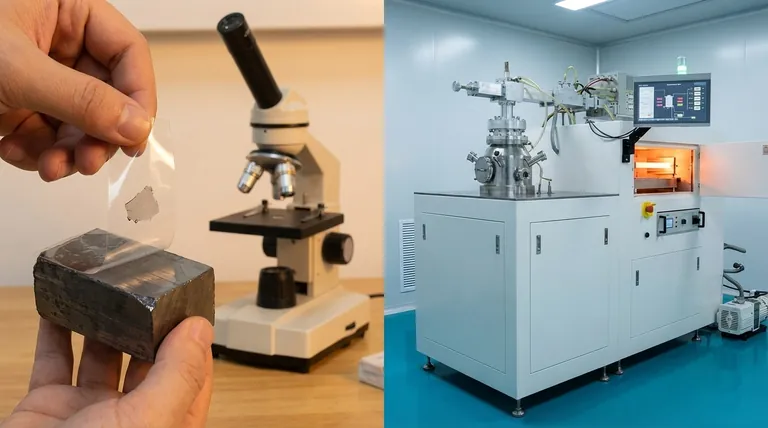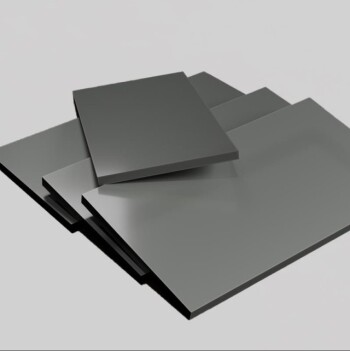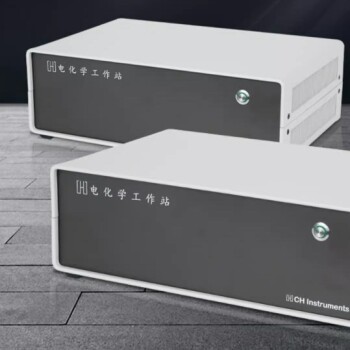For a hands-on demonstration or small-scale lab experiment, the easiest way to make graphene is through mechanical exfoliation, famously known as the "Scotch tape method." This top-down technique involves using adhesive tape to peel away layers from a piece of graphite until you are left with a single, one-atom-thick layer of graphene. While simple and effective for producing tiny, high-quality flakes, it is not a method for mass production.
The "easiest" method for making graphene is entirely dependent on your goal. Simple, low-cost methods are ideal for demonstration but yield small quantities, while industrial methods produce high-quality, large-area graphene but require complex and expensive equipment.

Two Fundamental Production Philosophies
Graphene synthesis is broadly divided into two main categories: "top-down" methods that start with bulk graphite and break it down, and "bottom-up" methods that build graphene atom by atom.
Top-Down: Deconstructing Graphite
Top-down approaches are conceptually simple: you take a block of graphite, which is essentially a stack of countless graphene sheets, and find a way to separate them.
The "Scotch Tape" Method (Mechanical Exfoliation)
This is the original, Nobel Prize-winning method and the simplest to conceptualize. By repeatedly peeling a piece of graphite with adhesive tape, you progressively thin the graphite flakes.
With care and a microscope, you can isolate a single-layer flake. It is incredibly simple and produces very high-quality, pristine graphene flakes, but it is a manual process that is not scalable for any practical application.
The "Blender" Method (Liquid Phase Exfoliation)
A more scalable "easy" method involves mixing graphite powder with a liquid (often water and a simple surfactant like dish soap) and blending it at high speed.
The shear forces created by the blender help to peel the layers of graphite apart, resulting in a dispersion of graphene flakes in the liquid. This method is excellent for producing bulk quantities of graphene flakes for use in composites, inks, or coatings, but the quality is lower and the flakes are typically multi-layered and smaller.
Bottom-Up: Building from Carbon Atoms
Bottom-up methods are far more controlled and are used for industrial and high-tech applications. They involve building the graphene lattice from individual carbon atoms onto a substrate.
Chemical Vapor Deposition (CVD)
CVD is the leading method for producing the large-area, high-quality graphene sheets required for electronics and advanced research.
In this process, a carbon-containing gas (like methane) is introduced into a high-temperature furnace containing a metal substrate, typically copper foil. The gas decomposes, and the carbon atoms arrange themselves into a single graphene layer on the surface of the metal. This method is complex, expensive, and requires specialized equipment.
Understanding the Trade-offs: Ease vs. Quality and Scale
No single method is universally "best." The choice always involves a trade-off between simplicity, the quality of the resulting graphene, and the ability to produce it at scale.
Simplicity and Cost
Mechanical and liquid-phase exfoliation are extremely low-cost and can be performed with household items or basic lab equipment.
CVD is at the other end of the spectrum, requiring vacuum furnaces, precise gas flow controllers, and high-purity chemicals, making it a high-cost, capital-intensive process.
Graphene Quality
The "Scotch Tape" method can produce nearly perfect, defect-free flakes of graphene, which is why it is still used in fundamental research.
CVD also produces very high-quality, continuous sheets of single-layer graphene, but they can have some defects or grain boundaries. Liquid exfoliation typically produces a mix of single and multi-layer flakes with more structural defects.
Scalability and Final Form
The key advantage of CVD is its scalability for producing large sheets suitable for electronics. The final product is a film of graphene on a substrate.
Liquid exfoliation is also scalable for producing large volumes of graphene flake dispersions, not continuous sheets. Mechanical exfoliation is entirely unscalable.
Choosing the Right Method for Your Goal
Your objective dictates the appropriate method. There is no one-size-fits-all answer, so you must align your technique with your intended outcome.
- If your primary focus is education or a simple demonstration: The "Scotch Tape" method is the easiest way to prove the concept and produce a microscopic, high-quality flake.
- If your primary focus is creating bulk material for composites or inks: Liquid Phase Exfoliation using a blender is the most accessible method for producing a usable quantity of graphene flakes.
- If your primary focus is high-performance electronics or advanced materials research: You will need access to industrial-grade methods like CVD to produce the required large-area, high-purity graphene films.
Ultimately, understanding the landscape of graphene production is about matching the tool to the task at hand.
Summary Table:
| Method | Best For | Key Advantage | Main Limitation |
|---|---|---|---|
| Scotch Tape (Mechanical Exfoliation) | Education, Basic Research | Produces pristine, high-quality flakes | Not scalable; microscopic yields |
| Blender (Liquid Phase Exfoliation) | Composites, Inks, Coatings | Simple, scalable for bulk flakes | Lower quality, multi-layer flakes |
| Chemical Vapor Deposition (CVD) | Electronics, Advanced Research | High-quality, large-area sheets | Complex, expensive equipment |
Ready to Scale Your Graphene Production?
Choosing the right synthesis method is just the first step. KINTEK specializes in providing the high-quality lab equipment and consumables needed for advanced graphene research and development, from CVD systems to materials for liquid phase exfoliation.
Let our experts help you select the perfect tools for your specific application. Contact KINTEL today to discuss how our solutions can accelerate your materials science projects and bring your innovations to life.
Visual Guide

Related Products
- Cylindrical Resonator MPCVD Machine System Reactor for Microwave Plasma Chemical Vapor Deposition and Lab Diamond Growth
- RF PECVD System Radio Frequency Plasma-Enhanced Chemical Vapor Deposition RF PECVD
- CVD Diamond Cutting Tool Blanks for Precision Machining
- Graphite Vacuum Furnace IGBT Experimental Graphitization Furnace
- Carbon Graphite Plate Manufactured by Isostatic Pressing Method
People Also Ask
- How do lab-grown diamonds compare to natural diamonds? Uncover the Truth About Origin, Price, and Value
- What is a microwave plasma reactor? Unlock Precision Synthesis of High-Performance Materials
- Which lab grown diamond process is best? Focus on Quality, Not the Method
- What is MPCVD method? A Guide to High-Purity Diamond Synthesis
- What is the difference between MPCVD and HFCVD? Choose the Right CVD Method for Your Application



















